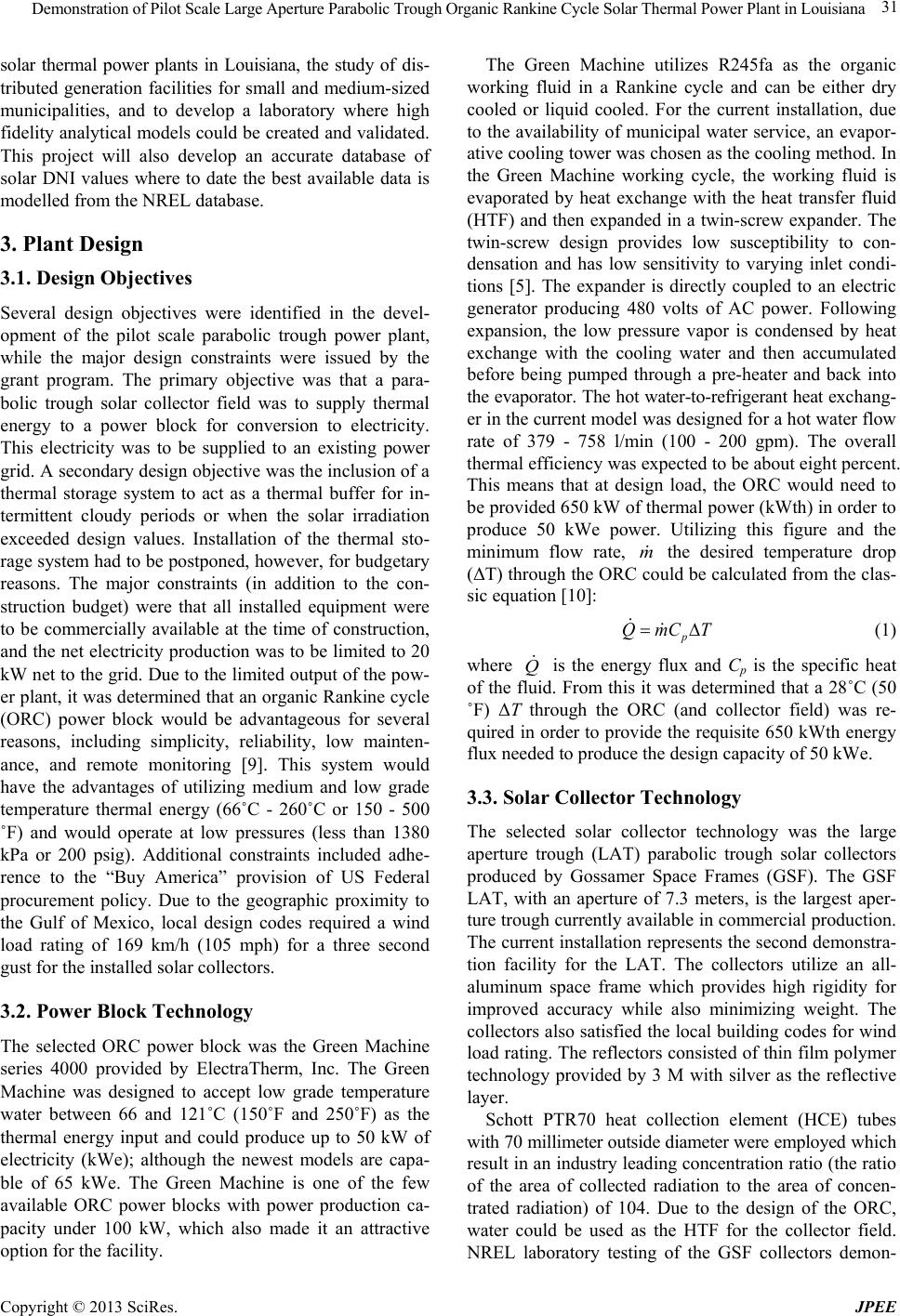
Demonstration of Pilot Scale Large Aperture Parabolic Trough Organic Rankine Cycle Solar Thermal Power Plant in Louisiana
Copyright © 2013 SciRes. JPEE
solar thermal power plants in Louisiana, the study of dis-
tributed generation facilities for small and medium-sized
municipalities, and to develop a laboratory where high
fidelity analytical models could be created and validated.
This project will also develop an accurate database of
solar DNI values where to date the best available data is
modelled from the NREL database.
3. Plant Design
3.1. Design Objectives
Several design objectives were identified in the devel-
opment of the pilot scale parabolic trough power plant,
while the major design constraints were issued by the
grant program. The primary objective was that a para-
bolic trough solar collector field was to supply thermal
energy to a power block for conversion to electricity.
This electricity was to be supplied to an existing power
grid. A secondary design objective was the inclusion of a
thermal storage system to act as a thermal buffer for in-
termittent cloudy periods or when the solar irradiation
exceeded design values. Installation of the thermal sto-
rage system had to be postponed, how ever, for bud getary
reasons. The major constraints (in addition to the con-
struction budget) were that all installed equipment were
to be commercially available at the time of construction,
and the net electricity produ ction was to be limited to 20
kW net to the grid. Due to the limited output of the pow-
er plant, it was determined that an organic Rankine cycle
(ORC) power block would be advantageous for several
reasons, including simplicity, reliability, low mainten-
ance, and remote monitoring [9]. This system would
have the advantages of utilizing medium and low grade
temperature thermal energy (66˚C - 260˚C or 150 - 500
˚F) and would operate at low pressures (less than 1380
kPa or 200 psig). Additional constraints included adhe-
rence to the “Buy America” provision of US Federal
procurement policy. Due to the geographic proximity to
the Gulf of Mexico, local design codes required a wind
load rating of 169 km/h (105 mph) for a three second
gust for the installed solar collectors.
3.2. Power Block Techn ology
The selected ORC power block was the Green Machine
series 4000 provided by ElectraTherm, Inc. The Green
Machine was designed to accept low grade temperature
water between 66 and 121˚C (150˚F and 250˚F) as the
thermal energy input and could produce up to 50 kW of
electricity (kWe); although the newest models are capa-
ble of 65 kWe. The Green Machine is one of the few
available ORC power blocks with power production ca-
pacity under 100 kW, which also made it an attractive
option f or t he facility.
The Green Machine utilizes R245fa as the organic
working fluid in a Rankine cycle and can be either dry
cooled or liquid cooled. For the current installation, due
to the availability of municipal water service, an evapor-
ative cooling tower was chosen as the cooling method. In
the Green Machine working cycle, the working fluid is
evaporated by heat exchange with the heat transfer fluid
(HTF) and then expanded in a twin-screw expander. The
twin-screw design provides low susceptibility to con-
densation and has low sensitivity to varying inlet condi-
tions [5]. The expander is directly coupled to an electric
generator producing 480 volts of AC power. Following
expansion, the low pressure vapor is condensed by heat
exchange with the cooling water and then accumulated
before being pumped through a pre-heater and back into
the evaporator. The hot water-to-refrigerant heat exchang-
er in the current model was designed for a hot water flow
rate of 379 - 758 l/min (100 - 200 gpm). The overall
thermal efficiency was expected to be about eight percent.
This means that at design load, the ORC would need to
be provided 6 50 kW of the rmal power (kW th) in orde r to
produce 50 kWe power. Utilizing this figure and the
minimum flow rate,
the desired temperature drop
(ΔT) through the ORC could be calculated from the clas-
sic equation [10]:
(1)
where
is the energy flux and Cp is the specific heat
of the fluid. From this it was determined that a 28˚C (50
˚F) ΔT through the ORC (and collector field) was re-
quired in order to provide the requisite 650 kWth energy
flux needed to produce the design capacity of 50 kWe.
3.3. Solar Collector Technol ogy
The selected solar collector technology was the large
aperture trough (LAT) parabolic trough solar collectors
produced by Gossamer Space Frames (GSF). The GSF
LAT, with an aperture of 7.3 meters, is the largest aper-
ture trough curre ntly available in commercial production.
The current installation represents the second demonstra-
tion facility for the LAT. The collectors utilize an all-
aluminum space frame which provides high rigidity for
improved accuracy while also minimizing weight. The
collectors also satisfied the local building codes for wind
load rating. The reflectors consisted of thin film polymer
technology provided by 3 M with silver as the reflective
layer.
Schott PTR70 heat collection element (HCE) tubes
with 70 mill imeter outs ide d iameter w ere e mployed which
result in an industry leading concentration ratio (the ratio
of the area of collected radiation to the area of concen-
trated radiation) of 104. Due to the design of the ORC,
water could be used as the HTF for the collector field.
NREL laboratory testing of the GSF collectors demon-